英语学案.doc Module7U 1听说课
《Module 7 Unit 1》导学案

Extension
Look , ask and answer.(课件展示)
Summary
1.Summarythis lesson.
2.Homework
(2)播放课文Activity1的动漫,并让逐句跟读。
(3)全班齐读,Let’s listen and say.
Activity 2 Text teaching
1.课件展示活动二图片引入:Daming introduces some photos, what’s in the picturs? Listen and answer the question:(Teach: chicken ,bear, pig)
教学准备:师:单词卡片、课文动画、自制课件。
环节
教学操作流程
教学反思
Warm up
1.Free talk: T: Goodmorning. How are you?
Ss: I’m fine. And how are you?
T: I’m fine too. What’s this?
Ss: Photo./horse.…
教学内容: Module 7Unit 2There are twelve boys on the bike.
教学目标:
1.能听说读本课新单词及短语:fruit chicken, bear,pig.
2.能运用There is a bear in this photo. It’s eating sweets. There are eleven pigs on the bike.They’re eating fruit and vegetables.这类语句来描述照片或图画场景。
Module7Unit1教案
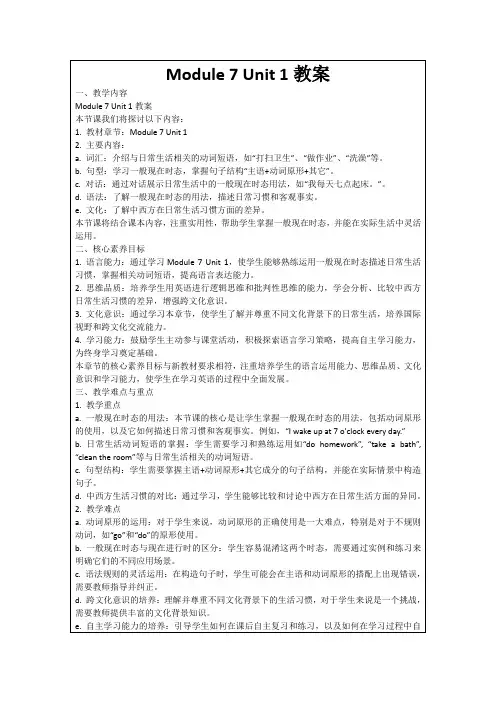
在实践活动方面,角色扮演活动受到了学生们的欢迎,他们能够在轻松愉快的氛围中练习一般现在时态。但同时,我也注意到部分学生在活动中过于紧张,导致表达不够流畅。因此,我考虑在以后的课堂中增加一些缓解紧张情绪的技巧训练,帮助他们在实际场景中更加自信地使用英语。
3.成果展示:每个小组将向全班展示他们的讨论成果和角色扮演的结果。
(四)学生小组讨论(用时10分钟)
1.讨论主题:学生将围绕“一般现在时态在日常生活中的应用”这一主题展开讨论。他们将被鼓励提出自己的观点和想法,并与其他小组成员进行交流。
2.引导与启发:在讨论过程中,我将作为一个引导者,帮助学生发现问题、分析问题并解决问题。我会提出一些开放性的问题来启发他们的思考。
b.日常生活动词短语的掌握:学生需要学习和熟练运用如“do homework”, “take a bath”, “clean the room”等与日常生活相关的动词短语。
c.句型结构:学生需要掌握主语+动词原形+其它成分的句子结构,并能在实际情景中构造句子。
d.中西方生活习惯的对比:通过学习,学生能够比较和讨论中西方在日常生活方面的异同。
d.跨文化意识的培养:理解并尊重不同文化背景下的生活习惯,对于学生来说是一个挑战,需要教师提供丰富的文化背景知识。
e.自主学习能力的培养:引导学生如何在课后自主复习和练习,以及如何在学习过程中自我纠错和总结规律。
在教学过程中,教师应针对这些重点和难点内容,设计丰富的教学活动,如角色扮演、小组讨论、语法点讲解和练习等,以确保学生能够透彻理解并掌握本节课的核心知识。同时,教师应关注学生的个体差异,提供个性化的指导和帮助,使每个学生都能在难点上取得突破。
Module7Unit1听说课教案
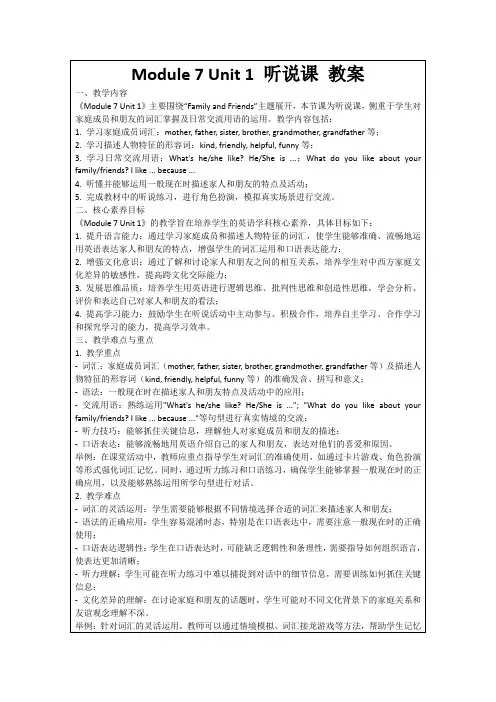
5.完成教材中的听说练习,进行角色扮演,模拟真实场景进行交流。
二、核心素养目标
《Module 7 Unit 1》的教学旨在培养学生的英语学科核心素养,具体目标如下:
1.提升语言能力:通过学习家庭成员和描述人物特征的词汇,使学生能够准确、流畅地运用英语表达家人和朋友的特点,增强学生的词汇运用和口语表达能力;
三、教学难点与重点
1.教学重点
-词汇:家庭成员词汇(mother, father, sister, brother, grandmother, grandfather等)及描述人物特征的形容词(kind, friendly, helpful, funny等)的准确发音、拼写和意义;
-语法:一般现在时在描述家人和朋友特点及活动中的应用;
-交流用语:熟练运用"What's he/she like? He/She is ..."; "What do you like about your family/friends? I like ... because ..."等句型进行真实情境的交流;
-听力技巧:能够抓住关键信息,理解他人对家庭成员和朋友的描述;
(二)新课讲授(用时10分钟)
1.理论介绍:首先,我们要了解一般现在时在描述人物特点中的应用。一般现在时是描述习惯性动作或状态的一种时态,它在描述家人和朋友时非常重要。
2.案例分析:接下来,我们来看一个具体的对话案例。这个案例展示了如何用一般现在时来描述一个人的性格和活动,以及它如何帮助我们更好地了解他人。
3.成果分享:每个小组将选择一名代表来分享他们的讨论成果。这些成果将被记录在黑板上或投影仪上,以便全班都能看到。
2016年秋七年级英语上册(外研版)教案Module.7Unit1教案
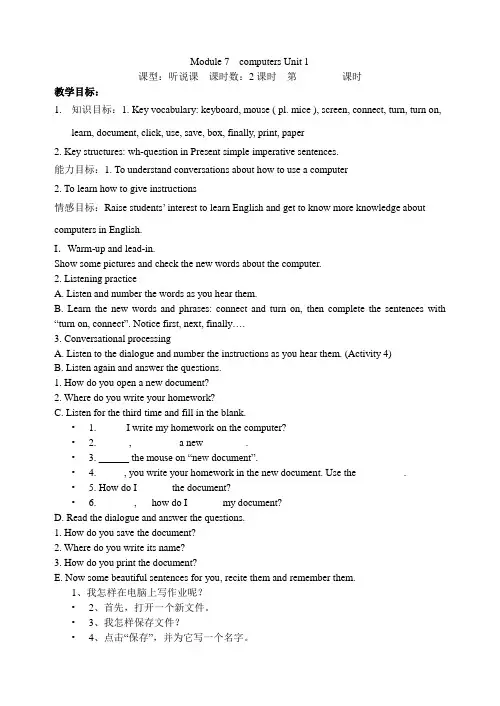
Module 7 computers Unit 1课型:听说课课时数:2课时第_________课时教学目标:1.知识目标:1. Key vocabulary: keyboard, mouse ( pl. mice ), screen, connect, turn, turn on,learn, document, click, use, save, box, finally, print, paper2. Key structures: wh-question in Present simple imperative sentences.能力目标:1. To understand conversations about how to use a computer2. To learn how to give instructions情感目标:Raise students’ interest to learn English and get to know more knowledge about computers in English.I.Warm-up and lead-in.Show some pictures and check the new words about the computer.2. Listening practiceA. Listen and number the words as you hear them.B. Learn the new words and phrases: connect and turn on, then complete the sentences with “turn on, connect”. Notice first, next, finally….3. Conversational processingA. Listen to the dialogue and number the instructions as you hear them. (Activity 4)B. Listen again and answer the questions.1. How do you open a new document?2. Where do you write your homework?C. Listen for the third time and fill in the blank.• 1. _____ I write my homework on the computer?• 2. ______, _____ a new ________.• 3. ______ the mouse on “new document”.• 4. _____, you write your homework in the new document. Use the _________.• 5. How do I ______ the document?• 6. _______, how do I ______ my document?D. Read the dialogue and answer the questions.1. How do you save the document?2. Where do you write its name?3. How do you print the document?E. Now some beautiful sentences for you, recite them and remember them.1、我怎样在电脑上写作业呢?____________________________________•2、首先,打开一个新文件。
高二英语选修七_Unit1_听说课名师教学设计
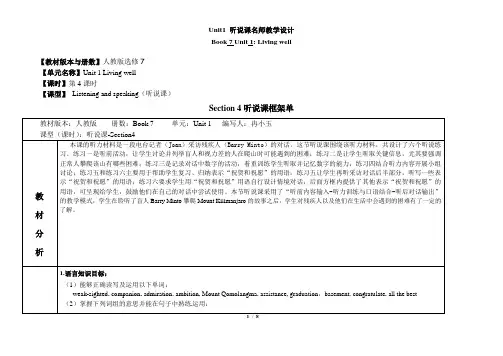
Unit1 听说课名师教学设计Book 7 Unit 1: Living well【教材版本与册数】人教版选修7【单元名称】Unit 1 Living well【课时】第4课时【课型】Listening and speaking(听说课)Section 4听说课框架单教材版本:人教版册数:Book 7 单元:Unit 1 编写人:冉小玉课型(课时):听说课-Section4教材分析本课的听力材料是一段电台记者(Joan)采访残疾人(Barry Minto)的对话。
这节听说课围绕该听力材料,共设计了六个听说练习。
练习一是听前活动,让学生讨论并列举盲人和视力差的人在爬山时可能遇到的困难;练习二是让学生听取关键信息,尤其要强调正常人攀爬该山有哪些困难;练习三是记录对话中数字的活动,着重训练学生听取并记忆数字的能力;练习四结合听力内容开展小组讨论;练习五和练习六主要用于帮助学生复习、归纳表示“祝贺和祝愿”的用语:练习五让学生再听采访对话后半部分,听写一些表示“祝贺和祝愿”的用语;练习六要求学生用“祝贺和祝愿”用语自行设计情境对话,后面方框内提供了其他表示“祝贺和祝愿”的用语,可呈现给学生,鼓励他们在自己的对话中尝试使用。
本节听说课采用了“听前内容输入-听力训练与口语结合-听后对话输出”的教学模式,学生在聆听了盲人Barry Minto攀爬Mount Kilimanjaro的故事之后,学生对残疾人以及他们在生活中会遇到的困难有了一定的了解。
1.语言知识目标:(1)能够正确读写及运用以下单词:weak-sighted, companion, admiration, ambition, Mount Qomolangma, assistance, graduation,basement, congratulate, all the best(2)掌握下列词组的意思并能在句子中熟练运用:1/ 82/ 8【本课时教学设计】3/ 84/ 85/ 86/ 87/ 88/ 8。
Modeule7Unit1Hecan’tsee
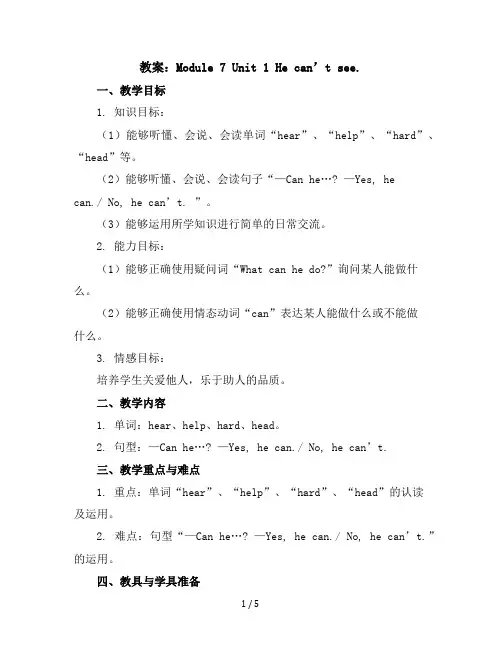
教案:Module 7 Unit 1 He can’t see.一、教学目标1. 知识目标:(1)能够听懂、会说、会读单词“hear”、“help”、“hard”、“head”等。
(2)能够听懂、会说、会读句子“—Can he…? —Yes, hecan./ No, he can’t. ”。
(3)能够运用所学知识进行简单的日常交流。
2. 能力目标:(1)能够正确使用疑问词“What can he do?”询问某人能做什么。
(2)能够正确使用情态动词“can”表达某人能做什么或不能做什么。
3. 情感目标:培养学生关爱他人,乐于助人的品质。
二、教学内容1. 单词:hear、help、hard、head。
2. 句型:—Can he…? —Yes, he can./ No, he can’t.三、教学重点与难点1. 重点:单词“hear”、“help”、“hard”、“head”的认读及运用。
2. 难点:句型“—Can he…? —Yes, he can./ No, he can’t.”的运用。
四、教具与学具准备1. 教具:PPT、录音机、磁带。
2. 学具:课本、练习册。
五、教学过程1. 热身(5分钟)(1)教师与学生进行简单的英语对话,激发学生的学习兴趣。
(2)学生自由交谈,分享彼此的日常生活。
2. 引入(10分钟)(1)教师展示图片,引导学生用“What can he do?”询问图片中的人物能做什么。
(2)学生回答问题,教师点评并给予鼓励。
3. 呈现(15分钟)(1)教师播放PPT,展示单词“hear”、“help”、“hard”、“head”的图片及例句。
(2)学生跟读单词和句子,教师纠正发音。
4. 练习(10分钟)(1)学生分组进行角色扮演,运用句型“—Can he…? —Yes, he can./ No, he can’t.”进行交流。
(2)教师随机抽取学生进行汇报,点评并给予鼓励。
5. 巩固(10分钟)(1)教师设计听力活动,学生听录音并回答问题。
Module7Unit1Listeningandspeaking教案英语八年级上册(1)
英语组教案设计T: What do you know about this famous play?Ss: I think it’s famous. ........Step2: Listen and number the pictures.First, Alice follows a white rabbit .Then , she sees the Cheshire Cat and has a tea party with the Mad Hatter at the March Hare’s house .Finally, she meets the Queen of Hearts .学法指导: 1. Ask Students watch the famous play.2. Ask students to read the play, and tell something about the story.Step3: Tell students something about the characters of the story.(通过交流引导本节话题,并在交流的过程中处理第一部分,还可以激发学生的学习兴趣)学法指导:1.Analysis of the characters of the story;2. Let Ss know the story in general.Step 4:Read and plete the storyPicture (1) One day , Alice __________with her sister by the river .And she saw a white rabbit. 录每个组员的得分情况意图:让学生明确本节课的主要任务,带着任务去学习。
并通过相关话题的表述导入新课。
操作方法:通过课件展示。
导入要与所学文本内容相关的图片、视频。
操作流程:师课件出示,生自读目标。
四年级上册英语教案- Module 7 Unit 1 There is a horse in thi
四年级上册英语教案- Module 7 Unit 1 There is a horse inthis photo.外研三起一、教学目标1.能听懂、会读、会说单词和短语:photo, horse, lion, monkey, elephant, giraffe, zebra2.能听懂、会说句型:“There is a/an + 名词+ in this photo.”3.能听懂、会说短文:“There is ahorse/lion/monkey/elephant/giraffe/zebra in this photo.”二、教学重点1.单词和短语的准确发音及理解。
2.句型“There is a/an + 名词+ in this photo.” 和短文的准确表达。
三、教学难点1.单词和短语的记忆和理解。
2.句型“There is a/an + 名词+ in this photo.” 和短文的口语表达。
四、教学准备1.PPT课件。
2.教学录音。
五、教学过程1. Warming UpT: Good morning/afternoon, boys and girls. Today, we are going to learn a new unit, Unit 1 in Module 7. Do you like looking at photos? (学生回答) Great! Let’s look at some photos.(出示一张包含多种动物的照片)T: Look at this photo. What animals can you see in this photo? (学生回答)T: Now, let’s learn some new words.2. PresentationT: (出示照片) Look at this photo. What animal can you see in this photo? (学生回答)T: Yes, it’s a horse. Let’s say。
一年级上册英语教案-Module7Unit1|外研社(一起)
一年级上册英语教案Module 7 Unit 1 | 外研社(一起)教学目标本节课旨在让学生掌握与食物相关的英语单词,如“蛋糕”、“苹果”等,并能够使用简单的英语句子表达自己的喜好。
同时,通过本节课的学习,培养学生的英语听说能力和团队合作意识。
教学内容单词:cake, apple, banana, orange, milk, water句子:I like教学重点与难点重点:掌握食物相关的英语单词和句子“I like”,能够用英语表达自己的喜好。
难点:正确发音单词和句子,理解并运用英语句型表达自己的喜好。
教具与学具准备教具:多媒体设备、PPT、单词卡片、食物图片、录音机学具:学生自备英语课本、笔记本、彩笔教学过程1. 导入:利用多媒体设备播放一首与食物相关的英语歌曲,引起学生的兴趣,同时展示一些食物图片,让学生猜测并用中文说出这些食物的名称。
2. 新课内容展示:利用PPT展示本节课要学习的单词和句子,同时用英语解释单词的意思,让学生跟读并模仿发音。
通过图片和动作示范,让学生理解句子的含义。
3. 小组活动:将学生分成小组,每组选择一种食物,用英语句子“I like”表达自己的喜好。
小组成员轮流发言,其他小组成员倾听并给予反馈。
4. 游戏环节:进行“猜猜我喜欢什么”的游戏,教师出示一张食物图片,学生用英语句子“I like”猜猜教师喜欢什么食物。
猜对的学生可以得到小奖励。
6. 作业布置:布置一些与食物相关的英语作业,如用英语描述自己喜欢的食物,或者画一幅与食物相关的图画并附上英语标签。
板书设计Module 7 Unit 1 Food I Like单词列表:cake, apple, banana, orange, milk, water句子:I like作业设计用英语描述自己喜欢的食物,并写下来。
画一幅与食物相关的图画,并附上英语标签。
课后反思本节课通过多媒体、图片和游戏等多种方式,激发了学生的学习兴趣,使他们能够积极参与课堂活动。
外研版英语七年级上册:Module 7:Unit 1-教案
教学设计外语教学与研究出版社《新标准》英语七年级上册Module Seven ComputersUnit One How do I write my homework on the computer?辽宁省大连市第39中学一、教材分析本模块以电脑为话题,分设三个课时进行学习。
本节课是这个模块的第一课时,是一节听说课型的新授课。
作为模块的第一课,它为第二、三单元不仅提供了话题和语境,同时也为学生们后来的学习扫清语言和文化的障碍。
在第一单元中,学生的听说活动都是围绕电脑而展开。
学生们通过学习对话,了解如何连接电脑各部件并开启电脑;如何使用电脑写作业,并且感知和运用行为动词以及行为动词一般现在时特殊疑问句的用法。
本单元中的内容与学生们的实际生活息息相关,激发了学生的学习兴趣,语言实践活动也比较好开展。
二、教学目标1.语言知识目标:词汇:能在语境下理解、辨认并运用词汇connect...to..., turn on, first, next, finally, save, print等。
语法:能理解并运用行为动词及行为动词一般现在时的特殊疑问句。
语音:能识别并正确朗读含有双元音/aʊ/、/əʊ/和辅音/f/、/v/的单词;能正确朗读一般现在时的特殊疑问句,能读出正确的语音语调。
2.语言技能目标:听:能听懂有关电脑操作的简单询问,能辨认电脑操作步骤顺序。
说:能分角色有感情地朗读对话;能在对话框架提示下,使用一般现在时的特殊疑问句及其回答描述和介绍用电脑做作业或做其他事情的步骤方法。
读:能读懂本篇关于电脑的对话。
写:能运用已学词汇写出操作电脑写作业的步骤。
3.学习策略目标:(1)借助点读技术,感知、领悟听力技巧和方法;(2)通过小组合作的方式,学会合作学习;4.情感态度价值观:在教学活动中,学生们通过实践参与讨论对电脑的功能和用途产生兴趣,合理使用电脑。
5. 教学重点和难点1)重点:能掌握新词汇短语connect, turn on, first, next, finally,save, print 等;能理解课文对话内容。
- 1、下载文档前请自行甄别文档内容的完整性,平台不提供额外的编辑、内容补充、找答案等附加服务。
- 2、"仅部分预览"的文档,不可在线预览部分如存在完整性等问题,可反馈申请退款(可完整预览的文档不适用该条件!)。
- 3、如文档侵犯您的权益,请联系客服反馈,我们会尽快为您处理(人工客服工作时间:9:00-18:30)。
5. I have chemistry this afternoon.(否定句)
I _______ ________ _________ this afternoon.
6. I get up at six. I have breakfast at ten past six. (合并成一句)
( ) 8. My sister __________ at home on Sunday.
A. stay B. staies C. stays
( ) 9. Let’s _______ a film _______tonight.
A. watch, / B. see. / C. watch, at
( ) 10. Would you like to invite _______ _______ your party?
8. We _____ to bed at nine o’clock.
教或学后思 Nhomakorabea作
业
做行之天下Unit 1练习题
二.句型转换。
1.We have Chineseat eight o’clock.(同上)
___________________________________________________
2.Today isTuesday.(同上)
____________________________________________________
课题
Unit 1听说课
主备教师
主审教师
学习目标
1. Master the school subjects
2. To understand conversation of time and school subjects in the listening
3. To talk about one’s lessons with given information
3.听录音补全对话
Daming: What day is it today?
Betty: It is_____ .What are your lessons today?
Daming: Today, we______ _______at eight o'clock. We have science____ _______ _______and we have maths at ten o'clock. I like______ .
3. We _____ to the playground.
4. They _____ an English lesson on Monday.
5. I _____ my homework in the afternoon.
6. You _____ home at four o’clock.
7. We ______ dinner at seven o’clock.
Listenning
1.listen for the first time and answer the question:
What is Betty’s favourite lesson?
_______________________________________
2. Listen and check the true sentences.(活动5)
8.We have _________(早餐) at 7:00 and have________(午饭) at 12:00
六用do have go完成句子
1. I _____ to school at eight o’clock.
2. They ____ a break at ten o’clock.
4.I have ______________(美术) in the morning.
5.I like ___________(化学) and_____________ (历史).
6.Let us ____________(开始) at 9:30.
7.He often ___________(吃) lunch at 12:00.
I get up at six ________ have breakfast at ten past six.
7.I like healthy food. (变一般疑问句)
_________ __________ __________ healthy food?
8.The piano lesson isat the Children’s park.(划线部分提问)
1)表示几点半用half.
2) past表示过。He goes past a park every day.
3)对具体几点的提问用what time
---- What time is it ?
---- It’s half past eleven.
3.What about you ?
What about ……?相当于How about …….?用来征求别人的意见或询问情况,
( ) 2. I get up late ________ this morning.
A. / B. in C. on
( ) 3. What time is it? Its _________.
A. Sunday B. September 15thC. three o’clock in the afternoon
意思是“…….怎么样?”其后接名词或动词ing形式。
例如:What about having a rest?
I’m fine. What about you ?
What about playing football?
4. And in the afternoon?这是一个省略句,完整的句子为“And what lessons do you have in the afternoon?
__________________________________________________
三、用所给词的适当形式填空
1. I like _______ (eat) fruit very much.
2. Would you like _______ (have) some fruit?
3. What about _______ (have) a break?
( ) 4. When is your Chinese lesson? It’s _____________
A. at ten past half B. at half past ten C. at ten half
( ) 5. We play______ football on ______ playground.
A. he , to B. him, to C. him, /
五.单词拼写。
1.Listen! They are _________(谈论) about the film.
2.It’s six____________(点钟) now.
3.Let’s go to the cinema at ___________(一半) past ten.
体育________12:00 _______ 6;30_________ 11:00________1:30_________
8:30_______ 4:30________2:00__________3:15_________4:45________
课内探究
Vocabulary
1完成活动1,2和3
课内提升
一、用英语写出下列时间。
1:00 ____________ 3:00 _____________ 5:00 ______________
2:30 _____________ / _______________
4:30 ____________/ ________________
6:30 _____________ / ________________
精讲点拨
1. What day is it today ?
1)相当What day is today?用来询问今天是星期几?
回答用星期。例如:It’s Friday.
2)今天是几号?则用:What’s the date today?
回答用日期。例如:It’s May 2nd.
2. It’s half past six.
Lingling: I_____ ____maths! We have chemistry at half____eleven. We_____ ______science today. In the afternoon, I have art at half past one and I have___ _____ _______at half past two. What about you, Betty?
学习重点难点
1.New words
2.时间按表达法
3.行为动词的一般现在时
学具
准备
多媒体录音机
学
习
过
程
Unit 1 I like maths!
课前延伸
写出下列单词
谈论讨论_______超过______美术______化学________历史_______
数学________语文________科学_______英语________政治_________
4. They _______(not leave) school at three.
5. Art is ______(I) favourite lesson.
